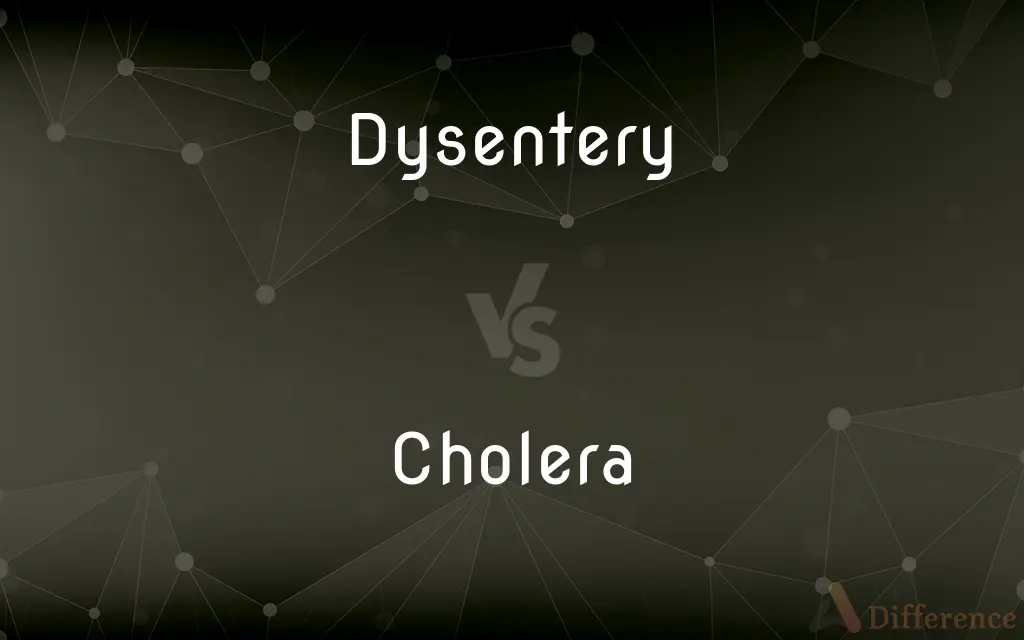Dysentery vs. Cholera — What's the Difference?
By Tayyaba Rehman & Urooj Arif — Updated on March 18, 2024
Dysentery is an inflammation of the intestines causing severe diarrhea with blood, while cholera is characterized by watery diarrhea and vomiting, leading to rapid dehydration.

Difference Between Dysentery and Cholera
Table of Contents
ADVERTISEMENT
Key Differences
Dysentery primarily affects the intestine, causing inflammation and resulting in severe diarrhea, often with blood and mucus. It can be caused by both bacterial and protozoan pathogens, with the two main types being bacillary dysentery (caused by bacteria) and amoebic dysentery (caused by a protozoan). Symptoms include abdominal pain, fever, and urgent need to defecate. On the other hand, cholera is specifically caused by the bacterium Vibrio cholerae and is characterized by acute, watery diarrhea that can lead to rapid dehydration and even death if untreated. Unlike dysentery, cholera diarrhea typically does not contain blood or mucus.
While dysentery may result from various pathogens and is marked by bloody diarrhea, cholera is always caused by Vibrio cholerae bacteria and is noted for extremely watery diarrhea, known as "rice-water stools." The transmission of both diseases is primarily through the consumption of contaminated food or water, highlighting the importance of sanitation and clean water supplies. However, the presence of blood and mucus in the stool is more associated with dysentery, whereas cholera stools are watery and may lead to severe dehydration more quickly.
The treatment for dysentery often involves antibiotics for bacterial causes or specific antiprotozoal medications for amoebic dysentery, along with rehydration therapy. In contrast, cholera treatment primarily focuses on rehydration, using oral rehydration salts (ORS) to replace lost fluids and salts, and antibiotics can be used to shorten the duration and severity of the illness.
Prevention strategies for both dysentery and cholera include ensuring access to clean water, practicing good sanitation and hygiene, and in some cases, vaccination. However, cholera has a more widely available and utilized vaccine compared to dysentery, where vaccination is not commonly employed as a preventative measure.
Both dysentery and cholera can cause outbreaks, especially in areas with poor sanitation, after natural disasters, or in refugee camps. However, cholera outbreaks have the potential to be more rapid and widespread due to the highly infectious nature of the Vibrio cholerae bacterium and its ability to cause severe dehydration within hours.
ADVERTISEMENT
Comparison Chart
Cause
Bacterial (Shigella, E. coli) or protozoan (Entamoeba histolytica)
Bacterium Vibrio cholerae
Symptoms
Bloody diarrhea, abdominal pain, fever, mucus in stools
Watery diarrhea, vomiting, rapid dehydration
Transmission
Contaminated food or water
Contaminated food or water, especially in poor sanitation areas
Treatment
Antibiotics for bacterial, antiprotozoal for amoebic, rehydration
Oral rehydration salts (ORS), antibiotics in severe cases
Characteristic Stool
Contains blood and mucus
Extremely watery, "rice-water stools"
Prevention
Clean water, sanitation, hygiene, limited vaccine availability
Clean water, sanitation, hygiene, vaccination
Compare with Definitions
Dysentery
An intestinal infection causing severe diarrhea with blood and mucus.
Dysentery outbreaks are common in areas with poor sanitation.
Cholera
An acute intestinal infection caused by Vibrio cholerae, leading to watery diarrhea and rapid dehydration.
Cholera can lead to severe dehydration within hours if untreated.
Dysentery
Can be caused by both bacteria (Shigella, certain types of E. coli) and protozoa (Entamoeba histolytica).
Amoebic dysentery is caused by the Entamoeba histolytica protozoan.
Cholera
Always caused by the bacterium Vibrio cholerae.
Consuming water contaminated with Vibrio cholerae can cause cholera.
Dysentery
Symptoms include bloody diarrhea, abdominal cramps, and fever.
The hallmark of dysentery is bloody diarrhea with visible mucus.
Cholera
Characterized by rapid onset of extremely watery diarrhea and vomiting, leading to dehydration.
Rice-water stools are a classic sign of cholera.
Dysentery
Treatment may include antibiotics for bacterial dysentery or antiprotozoal medications for amoebic dysentery, alongside rehydration therapy.
Antiprotozoal drugs are effective in treating amoebic dysentery.
Cholera
Primary treatment is oral rehydration solution (ORS); severe cases may require intravenous fluids and antibiotics.
ORS can quickly replenish fluids lost due to cholera.
Dysentery
Preventive measures include access to clean water, good sanitation practices, and hygiene.
Washing hands thoroughly can help prevent dysentery.
Cholera
Includes safe drinking water, improved sanitation, and vaccination in endemic areas.
Cholera vaccines are recommended for travelers to endemic regions.
Dysentery
Dysentery () is a type of gastroenteritis that results in bloody diarrhea. Other symptoms may include fever, abdominal pain, and a feeling of incomplete defecation.
Cholera
Cholera is an infection of the small intestine by some strains of the bacterium Vibrio cholerae. Symptoms may range from none, to mild, to severe.
Dysentery
Any of several inflammatory disorders of the intestines, especially the colon, characterized by abdominal pain, fever, and severe diarrhea often with blood and mucus in the stool, usually caused by infection with bacteria or parasitic protozoans.
Cholera
An acute infectious disease of the small intestine, caused by the bacterium Vibrio cholerae and characterized by profuse watery diarrhea, vomiting, muscle cramps, severe dehydration, and depletion of electrolytes. Also called Asiatic cholera.
Dysentery
(pathology) A disease characterised by inflammation of the intestines, especially the colon (large intestine), accompanied by pus (white blood cells) in the feces, fever, pain in the abdomen, high-volume diarrhea, and possible blood in the feces.
Cholera
Either of two unrelated diseases of domestic animals, fowl cholera or classical swine fever (hog cholera), that are often marked by severe diarrhea.
Dysentery
Diarrhea.
Cholera
(pathology) Any of several acute infectious diseases of humans and domestic animals, caused by certain strains of the Vibrio cholerae bacterium through ingestion of contaminated water or food, usually marked by severe gastrointestinal symptoms such as diarrhea, abdominal cramps, nausea, vomiting, and dehydration.
Dysentery
A disease attended with inflammation and ulceration of the colon and rectum, and characterized by griping pains, constant desire to evacuate the bowels, and the discharge of mucus and blood.
Cholera
One of several diseases affecting the digestive and intestinal tract and more or less dangerous to life, esp. the one commonly called Asiatic cholera.
Dysentery
An infection of the intestines marked by severe diarrhea
Cholera
An acute intestinal infection caused by ingestion of contaminated water or food
Common Curiosities
Are there vaccines for dysentery and cholera?
Vaccines are available for cholera and are recommended in endemic areas or during outbreaks. For dysentery, vaccines are not commonly used, with prevention focusing on sanitation and hygiene.
Can dysentery and cholera be fatal?
Yes, both can be fatal if untreated, due to severe dehydration and other complications, but prompt and effective treatment greatly reduces the risk of death.
What is the main treatment for cholera?
The main treatment is rehydration, using oral rehydration salts (ORS), and in severe cases, intravenous fluids and antibiotics may be required.
What distinguishes dysentery from cholera?
Dysentery is characterized by bloody diarrhea caused by bacteria or protozoa, while cholera, caused by Vibrio cholerae, leads to severe watery diarrhea and rapid dehydration.
How are dysentery and cholera transmitted?
Both are primarily transmitted through the consumption of contaminated food or water, often in areas with poor sanitation.
Is bloody diarrhea more common in dysentery or cholera?
Bloody diarrhea is a hallmark of dysentery, whereas cholera produces watery, non-bloody diarrhea.
Can both dysentery and cholera be treated with antibiotics?
Antibiotics are used in the treatment of bacterial dysentery and severe
What are "rice-water stools" in cholera?
"Rice-water stools" refer to the characteristic watery diarrhea of cholera, which is pale, milky in appearance, and resembles water used to wash rice.
What are the implications of untreated cholera?
Untreated cholera can lead to severe dehydration, electrolyte imbalance, and shock, potentially resulting in death within hours if not managed promptly.
Why is sanitation important in controlling dysentery and cholera?
Improved sanitation reduces the risk of contamination of food and water sources, thereby decreasing the incidence of both dysentery and cholera.
What is the role of hygiene in preventing dysentery and cholera?
Good personal and food hygiene, along with access to clean water and proper sanitation, are crucial in preventing both diseases.
How quickly do symptoms appear after infection with cholera?
Cholera symptoms can appear within a few hours to 5 days after ingestion of the bacteria, typically leading to rapid dehydration.
How does one prevent amoebic dysentery?
Preventing amoebic dysentery involves drinking clean, treated water, practicing good food and personal hygiene, and avoiding raw or unclean foods in areas where the disease is common.
Can dysentery lead to long-term health issues?
Chronic amoebic dysentery can cause long-term health issues such as liver abscesses, colitis, and increased risk of colorectal cancer.
How does climate affect the spread of dysentery and cholera?
Both diseases can see increased spread in warmer climates and during rainy seasons, as these conditions can facilitate the contamination of water sources and increase the likelihood of outbreaks.
Share Your Discovery

Previous Comparison
Backflip vs. Handspring
Next Comparison
Rectifier vs. InverterAuthor Spotlight
Written by
Tayyaba RehmanTayyaba Rehman is a distinguished writer, currently serving as a primary contributor to askdifference.com. As a researcher in semantics and etymology, Tayyaba's passion for the complexity of languages and their distinctions has found a perfect home on the platform. Tayyaba delves into the intricacies of language, distinguishing between commonly confused words and phrases, thereby providing clarity for readers worldwide.
Co-written by
Urooj ArifUrooj is a skilled content writer at Ask Difference, known for her exceptional ability to simplify complex topics into engaging and informative content. With a passion for research and a flair for clear, concise writing, she consistently delivers articles that resonate with our diverse audience.
















































